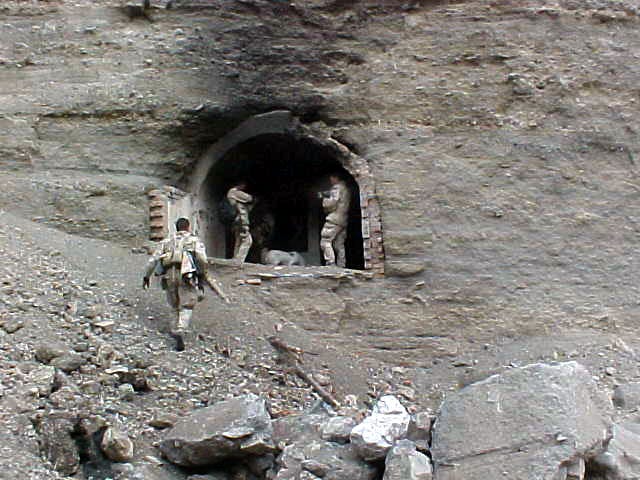It is no secret that the Trump administration is looking to withdraw more forces from Afghanistan, where there are reportedly 12,000 to 13,000 American troops stationed. There is mounting bipartisan pressure to extricate the U.S. from the so-called “endless wars.” And the president’s own desire to end, or at least greatly reduce, the American presence is well-known. But even if the goal is to withdraw from the Afghan war, it still matters how the U.S. goes about it.
Recently, White House national security adviser Robert O’Brien told Axios that while it is still possible the U.S. could do a deal with the Taliban, America’s military footprint may be reduced without one. “We’re working on it. But it has to be a good deal,” O’Brien said.
There’s just one problem: There is no good reason to think a good deal with al-Qaeda’s blood brothers can be had. After years of feckless on-again, off-again talks, the Taliban hasn’t shown any willingness to enter into true peace negotiations with the Afghan government. Instead, the jihadists are biding their time and extracting concessions from the Americans, whose time may be running out, while giving up little in return.
Last year, Secretary of State Mike Pompeo’s team put together a draft accord in which the Taliban would act as America’s de facto counterterrorism partner. The State Department hasn’t been forthcoming when it comes to the specifics of this arrangement. But Special Representative Zalmay Khalilzad was quick to publicly endorse the Taliban’s supposed counterterrorism assurances. “The Taliban have committed, to our satisfaction, to do what is necessary that would prevent Afghanistan from ever becoming a platform for international terrorist groups or individuals,” Khalilzad told the New York Times in January 2019. Although Khalilzad said the details still had to be worked out, the State Department was curiously eager to treat the Taliban as a responsible stakeholder.
Secretary Pompeo put all of his eggs in this basket—despite the Taliban’s sordid history of lies dating back to the 1990s. In September, after President Trump canceled a proposed meeting with the Taliban at Camp David, Pompeo told the American people that the Taliban was willing to “break from al-Qaeda publicly and permanently” as part of a deal. Pompeo also repeated one of the Obama administration’s favorite talking points, claiming that al-Qaeda is a “shadow of its former self in Afghanistan.” That wasn’t true during Obama’s tenure, and it isn’t true now. Just a few months before Pompeo’s proclamation, for instance, the top American military commander in Afghanistan, Gen. Austin Miller, conceded that al-Qaeda was operating “across the country.”
Indeed, many additional reasons for skepticism have come to the fore in the year since Khalilzad first vouched for the Taliban’s counterterrorism assurances. Whitewashing the Taliban is not necessary to draw down further from Afghanistan, or to leave it entirely. And it is because of the Taliban’s insidious terrorist nature, among other reasons, that America will have to continue managing the threats emanating from the region.
Consider the following evidence—all of which was available to the public in the 12 months since Khalilzad first endorsed the idea that the Taliban could be trusted.
In January 2019, the same month that Khalilzad told the Times that the Taliban was “committed” to restraining the jihadists, a United Nations monitoring team warned that the Taliban and al-Qaeda remain closely allied. The U.N.’s analysts described al-Qaeda’s relationship with the Taliban as “long-standing” and “strong,” finding that the international terrorist organization “continues to see Afghanistan as a safe haven for its leadership.” In fact, Ayman al-Zawahiri, the global head of al-Qaeda, remains firmly in the Taliban’s corner. Zawahiri, who has tens of thousands of followers and supporters across several countries, has sworn his own personal allegiance to the Taliban’s top leader, Haibatullah Akhundzada.
Also in January 2019, the Office of the Director of National Intelligence (ODNI) presented its annual worldwide threat assessment to Congress, producing a map of al-Qaeda’s extensive global presence, including in Afghanistan. Al Qaeda’s “affiliate in South Asia” – that is, Al Qaeda in the Indian Subcontinent (AQIS)—“provides support to the Taliban,” the ODNI noted.
In February, the lead inspector general office for Operation Freedom’s Sentinel, submitted its quarterly oversight report to Congress. Citing recent intelligence from U.S. Forces-Afghanistan (USFOR-A), the inspector general pointed to al-Qaeda’s presence in seven Afghan provinces (Kabul, Badakshan, Kunar, Nangarha, Paktia, Helmand and Nimroz). USFOR-A said that al-Qaeda cells “likely operate in Taliban-controlled areas.” The same military sources indicated that there were just 200 al-Qaeda fighters in all of Afghanistan, but that specific estimate is dubious. The U.S. has been unable to accurately assess the number of al-Qaeda fighters in-country for years, and its current estimates do not include a constellation of groups that are known to be intertwined with both al-Qaeda and the Taliban. The geographic breadth of al-Qaeda’s operations also implies a much deeper bench of talent than the lowball figure.
In March 2019, al-Qaeda reminded Afghan and American officials of its presence in still another province: Ghazni. Afghanistan’s Ministry of Defense said it killed 31 AQIS members, including nine who were planning to serve as suicide bombers, during a series of airstrikes. Al-Qaeda’s foothold in Ghazni, a hotbed of Taliban activity, has long been known.
In April 2019, the U.N.’s monitoring analysts authored another report (released in June), warning that the Taliban continues “to be the primary partner for all foreign terrorist groups operating in Afghanistan,” namely al-Qaeda and affiliated groups. The only noteworthy exception is the Islamic State, which is opposed to the Taliban and al-Qaeda. “Al-Qaeda has grown stronger operating under the Taliban umbrella across Afghanistan and is more active than in recent years,” the UN team reported. The authors added: “Al-Qaeda members act as instructors and religious teachers for Taliban personnel and their family members.” The U.N.’s analysts pointed to a series of data points concerning various al-Qaeda-affiliated groups in Afghanistan, including those comprised of Tajik, Uighur, and Uzbek jihadis. The State Department hasn’t explained how its proposed deal with the Taliban would address the security threats they pose.
Even though al-Qaeda often prefers to hide the extent of its hand, the group occasionally lifts up its veil. For instance, in May 2019, al-Qaeda released a video titled, “Under the Shade of the Islamic Emirate: Paktika—Ambush on the Convoy of Afghan National Army in the Hindi Mountains.” Although the video highlighted a raid that occurred some time ago, the production underscored two simple facts: Al-Qaeda fights under the Taliban’s banner and remains loyal to the Taliban’s senior leadership. The “Islamic Emirate” mentioned in its title is the Taliban’s authoritarian state in Afghanistan. Al-Qaeda continues to fight for its resurrection.
In June 2019, the Department of Defense reported to Congress that al-Qaeda and AQIS “routinely support, train, work, and operate with Taliban fighters and commanders.” Al-Qaeda “maintains an enduring interest in attacking U.S. forces and Western targets,” the report’s authors noted. The Pentagon also included this warning:
Even if a successful political settlement with the Taliban emerges from ongoing talks, AQ, ISIS-K, and some unknown number of Taliban hardliners will constitute a substantial threat to the Afghan government and its citizens, as well as to the United States and its Coalition partners. This enduring terrorist threat will require the United States, the international community, and the ANDSF [Afghan National Defense and Security Forces] to maintain a robust [counterterrorism] capability for the foreseeable future.
In July 2019, the Taliban released a video justifying the 9/11 hijackings. “This heavy slap on their dark faces was the consequence of their interventionist policies and not our doing,” a Taliban narrator says as footage of United Airlines Flight 175 slamming into the World Trade Center is shown on screen. The video glorified other terrorist operations in the West, including the 2004 Madrid train bombings and the 7/7/05 attacks in London, as well. The Taliban’s main argument – that America and European nations deserve to be attacked because of their policies – was Mullah Omar’s chief talking point in the weeks following 9/11, when the Taliban founder refused to turn over Osama bin Laden. All these years later, the Taliban hasn’t repudiated Omar’s decision.
Suhail Shaheen, one of the lead Taliban negotiators in Qatar, has managed to garner favorable press coverage at times. But in August 2019 he said something that was telling. When CBS News asked him about 9/11, the Taliban representative played dumb. “Still it is not known who was behind that,” Shaheen claimed. “If there is proof given to us, we are ready to try [the person responsible],” he added.
These are not the words of a man who should be trusted as America’s counterterrorism guarantor. Al-Qaeda’s culpability, which the group has freely admitted on numerous occasions, is well-documented. Moreover, the Taliban’s responsibility for harboring and allying with al-Qaeda prior to and after 9/11 are well-attested in the 9/11 Commission Report, among other sources. Instead of coming clean about all of this as part of a true peace effort, Shaheen continues to obfuscate. After his CBS News interview raised some eyebrows, Shaheen issued a follow-up tweet, which didn’t help matters. He still couldn’t bring himself to admit what happened 18-plus years ago. For those in American policymaking circles who are so eager to play disconnect the dots between the Taliban and al-Qaeda, Shaheen’s comments (not to mention the Taliban’s July 2019 video and a wealth of other evidence) raise a straightforward question: Why won’t the Taliban simply disavow 9/11 in a clear, public manner after all these years? Wouldn’t that be an easy “confidence-building” measure in pursuit of true peace?
On September 14, the White House announced the death of Hamza bin Laden – Osama’s biological and ideological heir. The junior bin Laden had become an increasingly prominent voice in al-Qaeda’s global network since the summer of 2015, when Ayman al-Zawahiri introduced him as a young “lion.” Hamza’s death, on an unknown date some months before, was significant – even if we can’t be sure just how important he really was.
While there’s no question that al-Qaeda was leaning on the junior bin Laden name to speak to a younger generation of would-be believers, Hamza’s precise role in the organization was never made public. The White House’s statement on his death emphasized his “high-ranking” stature and “leadership skills,” but was curiously devoid of any specifics. We do not exactly when he was killed, nor where – we were only told somewhere “in the Afghanistan/Pakistan region.” The White House said that Hamza was “responsible for planning and dealing with various terrorist groups,” but didn’t name those organizations. It is possible, perhaps likely, that Hamza was working with the Taliban. Like his father before him, and Ayman al-Zawahiri, Hamza swore his fealty to the Taliban’s supreme leader.
Three U.S. intelligence officials have told The Dispatch that Hamza was indeed supporting the insurgency in Afghanistan, though the precise details haven’t been made public.
Also in mid-September 2019, Afghan forces discovered that a Taliban warehouse in Ghazni Province was storing explosives for AQIS, whose bomb-makers intended to strike targets in Kabul and “major cities across Afghanistan.”
Later in September, the first emir of AQIS, Asim Umar, was killed in a joint Afghan-American raid on a Taliban stronghold in Musa Qala, Helmand. Umar was perhaps the most senior al-Qaeda operative in the country at the time of his death. Zawahiri, bin Laden’s successor, entrusted him with the stewardship of AQIS, which was formed in 2014 for the expressed purpose of reinstalling the Taliban’s totalitarian rule. Under Umar’s direction, AQIS exported jihad throughout the region—to Bangladesh, Kashmir and elsewhere. He had threatened America and vowed, in a treatise he published in 2017, that Trump’s “America First” policy signaled Western defeat in Afghanistan and the end of America’s status as a mighty power. Umar’s argument was an exaggeration. But it goes to show the importance al-Qaeda has placed on a Taliban-led jihadist victory.
Umar’s courier, a man who ran messages back and forth to Zawahiri, was among several other al-Qaeda loyalists who were also killed in the Musa Qala raid. The counterterrorism operation was controversial, in part, because civilians were also killed. Al-Qaeda’s men are embedded within Taliban sanctuaries, making it difficult to get at them. There is no publicly available evidence that the Taliban, which denied Umar’s presence at its compound, is willing to come clean about the AQIS men fighting under the “shade” of its Islamic Emirate.
Then, in October 2019, Afghan forces killed Qari Burhan in the eastern Logar Province. Burhan was a commander in the so-called Haqqani Network, which is an integral part of the Taliban’s hierarchy and also al-Qaeda’s closest ally. The Afghan government accused him of orchestrating some of the most devastating suicide bombings in Kabul over the past eight years. In its announcement of Burhan’s death, the Afghan Ministry of Defense tied him to al-Qaeda, saying that while he “was responsible” for the “Taliban military commission in the Logar province,” he was also “one of the most trusted members of the Haqqani terrorist network, which worked closely with al-Qaeda to carry out terrorist activities and transport suicide bombers in Ghazni and Logar.”
Also in October, the Taliban secured the release of one of its men, Maulawi Abdul Rashid Baluch, in exchange for three Indian engineers the group was holding hostage. The U.S. Treasury Department designated Rashid as a global terrorist in 2015, reporting that he was responsible for killing a U.S. soldier in an improvised explosive device (IED) attack. Importantly, Treasury explained that Rashid “served as a Taliban liaison officer to al Qaeda (AQ) and was responsible for planning meetings between Taliban senior leadership and AQ members in Karachi, Pakistan.”
Afghan President Ashraf Ghani announced in November 2019 that his government would release three senior Haqqani Network leaders in exchange for two professors, one American and one Australian, both of whom were kidnapped in 2016. The release of the three jihadists was demanded by their boss and family member, Sirajuddin (“Siraj”) Haqqani, who has worked with al-Qaeda for many years. Indeed, the Haqqani Network is a U.S.-designated terrorist organization in no small part due to its intimate relationship with al-Qaeda. Siraj’s father, Jalaluddin, hosted Osama bin Laden along the border of Afghanistan and Pakistan in the 1980s and incubated some of al-Qaeda’s first military leaders in Haqqani camps. Al-Qaeda continues to refer to Siraj as its emir. Siraj has also been the deputy leader (No. 2 overall) of the Taliban’s Islamic Emirate since 2015.
The Haqqani clan members released in November include Anas Haqqani, Siraj’s younger brother, and Haji Malik Khan, Siraj’s uncle. Anas has raised funds from Arab donors throughout the Gulf, while Khan has acted as an emissary to the al-Qaeda-allied Pakistani Taliban. Both of them, in other words, have portfolios that extend outside of Afghanistan’s borders. Given Khan’s high-profile role in the Afghan insurgency, NATO described his capture in 2011 as “a significant milestone in the disruption of the Haqqani Network.”
The Haqqanis, a family of power brokers, have hosted foreign jihadis since the 1980s. And that’s one reason, among many, why we still see foreign fighters throughout Afghanistan today. But the Taliban, purely for public relations purposes, is especially sensitive to reports about the role of foreigners on the battlefield. In fact, the Taliban blatantly lies about it.
The Taliban’s dishonesty was on display yet again in late 2019. The Turkistan Islamic Party (TIP), a primarily Uighur al-Qaeda-affiliated group, released a video glorifying its role in the Afghan insurgency. The production was standard jihadi fare. But the Taliban’s media team quickly began spinning an alternative narrative, one in which the TIP video was really part of some nefarious plot to sow “mistrust.” But there is no reason to trust the Taliban in the first place. The footage was released by the TIP, which has fought alongside the Taliban since prior to 9/11. And multiple independent reports, including the UN analyses cited above, further attest to the TIP’s ongoing presence.
Yet, in early December 2019, the Taliban’s spokesman went so far as to claim there “are no foreign nationals present in Afghanistan,” because they all supposedly left after the 2001 U.S.-led invasion. It is an absurd claim, as ample evidence exists showing this isn’t remotely true. But it raises another obvious question: Why would anyone think the Taliban can be trustworthy with respect to international terrorism, when the group won’t even admit that international terrorists are present in Afghanistan?
To recap the past 12 months: The United Nations, Defense Department, Office of the Director of National Intelligence and other official sources confirm that al-Qaeda continues to support the Taliban. Operational evidence, such as the September 2019 raid in Musa Qala, Helmand, demonstrates that al-Qaeda figures remain embedded in Taliban strongholds. Al-Qaeda and affiliated groups occasionally advertise their presence, but the Taliban refuses to publicly acknowledge it. The Taliban’s propagandists justify 9/11, while one of its chief representatives claims we don’t know who did it. Meanwhile, the Taliban arranges for prisoner exchanges, in which al-Qaeda-linked jihadis are swapped for civilians.
Simply put, the Taliban continues to lie about terrorism. As of early 2019, the State Department was willing to endorse the lie.
It is not clear why anyone would think this is in America’s interest. The U.S. can continue to withdraw its forces from Afghanistan without entering into a bad deal with the Taliban.
Photograph of Navy SEALs exploring a cave used by Taliban and al-Qaeda fighters by the U.S. Navy, via Wikimedia Commons.






Please note that we at The Dispatch hold ourselves, our work, and our commenters to a higher standard than other places on the internet. We welcome comments that foster genuine debate or discussion—including comments critical of us or our work—but responses that include ad hominem attacks on fellow Dispatch members or are intended to stoke fear and anger may be moderated.
With your membership, you only have the ability to comment on The Morning Dispatch articles. Consider upgrading to join the conversation everywhere.